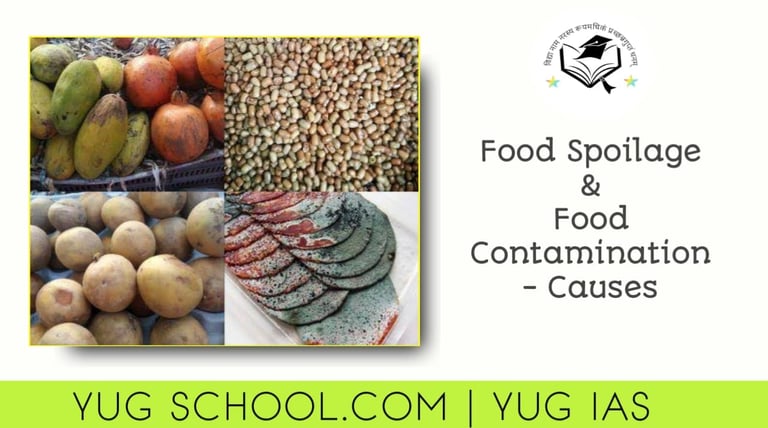Causes of Food Spoilage and Food Contamination
Food Spoilage and Contamination are two distinct issues that can render food unsafe for consumption.
HOME SCIENCE


Food Spoilage and Contamination are two distinct issues that can render food unsafe for consumption.
Food spoilage is the natural breakdown of food caused by various factors, primarily microorganisms like bacteria, molds, and yeasts. These microbes feed on the food, causing it to rot, become slimy, discolored, or develop an unpleasant odor. Spoiled food is generally not harmful but simply unpleasant to eat.
Here are the main factors that contribute to food spoilage:
Microorganisms: Bacteria, molds, and yeasts are the most common culprits behind food spoilage. They thrive in warm, humid environments and can multiply rapidly, breaking down the food and producing waste products that contribute to spoilage.
Temperature: Improper storage temperature is a major contributor to food spoilage. The "danger zone" for foodborne bacteria growth is between 40°F (4°C) and 140°F (60°C). Leaving perishable foods in this temperature range for extended periods allows bacteria to multiply quickly, accelerating spoilage.
Moisture: Excess moisture creates a favorable environment for microbial growth. Foods with high moisture content, such as fruits, vegetables, and meat, are more susceptible to spoilage if not stored properly.
Oxygen: While some bacteria thrive without oxygen (anaerobic), many spoilage microorganisms require oxygen for growth (aerobic). Therefore, exposure to air can accelerate spoilage in certain foods.
Light: Light can also play a role in spoilage, particularly for some fruits and vegetables. Light exposure can trigger chlorophyll breakdown, leading to discoloration and loss of nutrients.
On the other hand, food contamination is the introduction of harmful substances, such as bacteria, viruses, parasites, chemicals, or toxins, into food. Unlike spoilage, contaminated food may not always show any outward signs of spoilage but can still cause foodborne illnesses if consumed.
Some common causes of food contamination are:
Improper handling: Poor handling practices during food preparation, such as not washing hands properly or using contaminated utensils, can introduce harmful bacteria or viruses into food.
Cross-contamination: This occurs when raw or contaminated food comes into contact with cooked or ready-to-eat foods. This can happen through improper handling of cutting boards, utensils, or even surfaces.
Contaminated water: Using contaminated water for washing food or during food processing can introduce harmful bacteria or parasites into the food.
Inadequate cooking: Undercooking meat, poultry, or eggs can leave harmful bacteria alive, which can multiply and cause illness if consumed.
Chemical contamination: Food can also be contaminated with harmful chemicals, such as pesticides, cleaning agents, or industrial pollutants, during production, processing, or storage.
It's important to follow proper food safety practices to prevent both food spoilage and contamination. These practices include maintaining good hygiene, storing food at proper temperatures, cooking food to safe internal temperatures, and avoiding cross-contamination. By following these guidelines, you can help ensure that the food you eat is safe and enjoyable.
